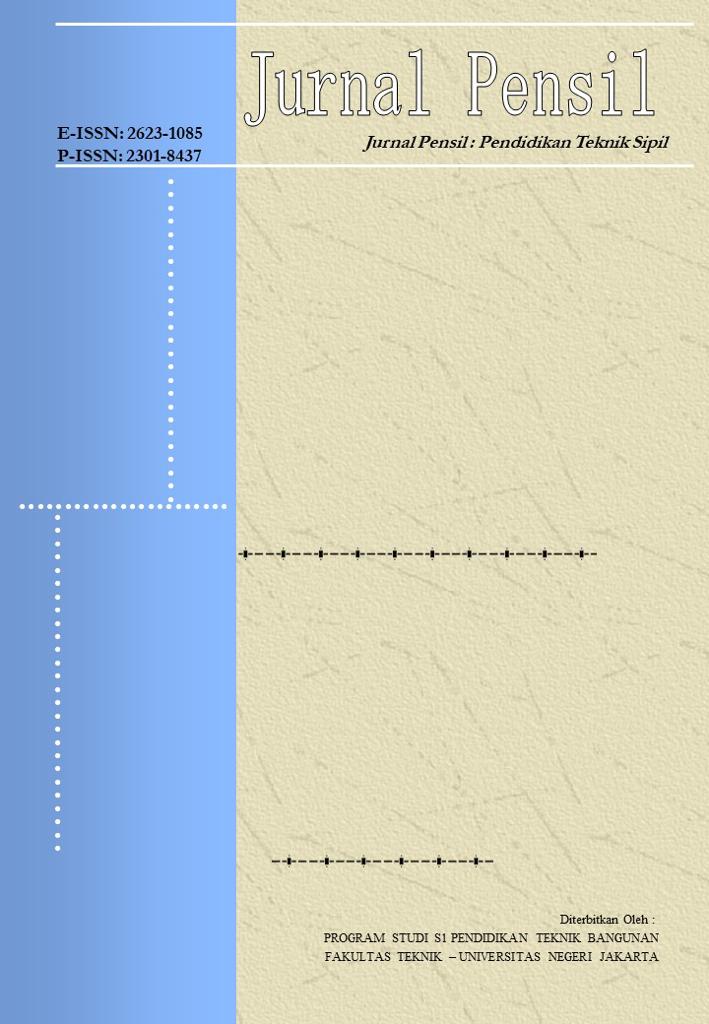STUDY OF PILLAR DIMENSION VARIATIONS MODELLING ON RIVER GEOMORPHOLOGY
DOI:
https://doi.org/10.21009/jpensil.v12i3.32680Keywords:
Pier, River, ScourAbstract
The behavior of river flow patterns on the condition of the pillar dimensions can affect the geomorphology conditions of the river, namely the unbalanced local scouring between sediment transport and sediment supply so that it will affect the strength of the pillar. This study aims to study the effect of pillar dimensions on scour depth and channel base changes in the pillar area. The method of observation was carried out by simulations using Nays2DH with the same parameters for each test of each dimension with discharge (Q) = 0.5 m3/s, sediment diameter (D50) = 0.35 mm, channel width (B) = 5 m, channel length (L) = 25 m, slope (i) = 0.005 and drainage time (t) = 7200 s. The simulation results show the basic scour pattern of the channel which has the smallest value, the diamond type pillar. Degradation - Basic channel agitation on diamond type pillars, showing a pattern that tends to be evenly distributed compared to semi rounded, rectangle, or octagonal types. Period (t) 7200 s downstream of the pillar, semi rounded type scours change <0.3 m, rectangle type scours changes <0.4 m, octagonal type scours changes <0.4 m, and diamond type scours changes <0.2 m. So the dimensions of the diamond type are more effective in reducing the depth of scour.
References
Ali, M. S., Hasan, M. M., & Haque, M. (2017). Two-Dimensional Simulation of Flows in an Open Channel with Groin-Like Structures by iRIC Nays2DH. Mathematical Problems in Engineering, 2017, 1–10. https://doi.org/10.1155/2017/1275498
Al-Shukur, A.-H. K., & Obeid, Z. H. (2016). Experimental Study of Bridge Pier. International Journal of Civil Engineering and Technology (IJCIET), 7(1), 162–171.
Ariyanto, A. (2010). Analisis Bentuk Pilar Jembatan Terhadap Potensi Gerusan Lokal. Jurnal APTEK, 2(1), 41–51.
Bento, A. M., Couto, L., Pêgo, J. P., & Viseu, T. (2018). Advanced characterization techniques of the scour hole around a bridge pier model. E3S Web of Conferences, 40. https://doi.org/10.1051/e3sconf/20184005066
Brandimarte, L., Paron, P., & Di Baldassarre, G. (2012). Bridge pier scour: A review of processes, measurements and estimates. Environmental Engineering and Management Journal, 11(5), 975–989. https://doi.org/10.30638/eemj.2012.121
Cambodia, M. (2020). Analisis Gerusan Lokal pada Pilar Jembatan Kereta Api BH. 337 akibat Aliran Sungai Cikao. Teknika Sains : Jurnal Ilmu Teknik, 5(2), 44–53. https://doi.org/10.24967/teksis.v5i2.1085
Carnacina, I., Leonardi, N., & Pagliara, S. (2019). Characteristics of flow structure around cylindrical bridge piers in pressure-flow conditions. Water (Switzerland), 11(11). https://doi.org/10.3390/w11112240
Chaudhuri, S., Das, V. K., & Debnath, K. (2020). Comparison of Scour Mechanisms and Downstream Bed Modification Around Circular Pier For Different Stream Bed -Characteristics - An Experimental Approach (Issue November).
Duarte, C. F., Nadim, N., & Chandratilleke, T. T. (2019). Experimental study of granular bed erosion and sedimentation subjugated to the secondary flow structures in curved ducts. Advances in Mechanical Engineering, 11(11), 1–14. https://doi.org/10.1177/1687814019885255
Escauriaza, C., & Sotiropoulos, F. (2011). Initial stages of erosion and bed form development in a turbulent flow around a cylindrical pier. Journal of Geophysical Research: Earth Surface, 116(3), 1–24. https://doi.org/10.1029/2010JF001749
Gartina, R., & Roestaman. (2015). Analisis Kekuatan Struktur Beton Pilar 2 Penahan Siphon Cisangkan. Jurnal Konstruksi, 13(1), 1–10.
Gazi, A. H., & Afzal, M. S. (2020). A review on hydrodynamics of horseshoe vortex at a vertical cylinder mounted on a flat bed and its implication to scour at a cylinder. Acta Geophysica, 68(3), 861–875. https://doi.org/10.1007/s11600-020-00439-8
Habib, A. A., & Nassar, M. A. (2019). Modelling of Deposition and Erosion Processes along A 180° Open Canal Bend by NAYS2DH in iRIC. Engineering Heritage Journal, 3(2), 01–05. https://doi.org/10.26480/gwk.02.2019.01.05
Ilham, V. A., & Sufrianto. (2022). Effect of Flow Velocity on bedload Sediment Transport at the Jeneberang River Estuary with Nays2DH Model Simulation. Jurnal on Management and Education Human Development, 02(01), 50–57.
Kadono, T., Okazaki, S., Kabeyama, Y., & Matsui, T. (2020). Effect of angle between pier and center of river flow on local scouring around the bridge pier. Water (Switzerland), 12(11), 1–13. https://doi.org/10.3390/w12113192
Khan, M. K., Muzzamil, M., & Javed Alam. (2016). Bridge Pier Scour: A review of mechanism, causes and geotechnical aspects. Age Amu Aligarh, April 2016, 1–6. https://www.researchgate.net/publication/312499136_Bridge_Pier_Scour_A_review_of_mechanism_causes_and_geotechnical_aspects
Lam, K., Gong, W. Q., & So, R. M. C. (2008). Numerical simulation of cross-flow around four cylinders in an in-line square configuration. Journal of Fluids and Structures, 24(1), 34–57. https://doi.org/10.1016/j.jfluidstructs.2007.06.003
Lee, F. Z., Lai, J. S., Lin, Y. Bin, Liu, X., Chang, K. C., Lin, C. F., & Chang, C. C. (2019). Monitoring and simulation of bridge pier scour depth. Scour and Erosion IX - Proceedings of the 9th International Conference on Scour and Erosion, ICSE 2018, 03007, 633–637. https://doi.org/10.1201/9780429020940-91
Man, C., Zhang, G., Hong, V., Zhou, S., & Feng, Y. (2019). Assessment of Turbulence Models on Bridge-Pier Scour Using Flow-3D. World Journal of Engineering and Technology, 07(02), 241–255. https://doi.org/10.4236/wjet.2019.72016
Maritz1, J. A., Malan1, D. F., Malan, D. F., Malan, J. A., & Maritz, J. A. (2023). A study of the effect of pillar shape on pillar strength Dates: How to cite. The Journal of the Southern African Institute of Mining and Metallurgy, 123(5), 235–244. https://doi.org/10.17159/2411
Melville, B. W. (1997). Pier and Abutment Scour: Integrated Approach. Journal of Hydra, 125–137.
Muhsen, N. A. A., & Khassaf, S. I. (2023). The study of the local scour behaviour due to interference between abutment and two shapes of a bridge pier The study of the local scour behaviour due to interference between abutment and two shapes of a bridge pier. Journal of Water and Land Development, 55(X–XIII), 240–250. https://doi.org/10.24425/jwld.2022.142327
Murtaza, G., Hashmi, H. N., Naeem, U. A., Khan, D., & Ahmad, N. (2018). Effect of Bridge Pier Shape on Scour Depth at Uniform Single Bridge Pier. Mehran University Research Journal of Engineering and Technology, 37(3), 539–544. https://doi.org/10.22581/muet1982.1803.08
Omara, H., Ookawara, S., Nassar, K. A., Masria, A., & Tawfik, A. (2022). Assessing local scour at rectangular bridge piers. Ocean Engineering, 266(P3), 1–13. https://doi.org/10.1016/j.oceaneng.2022.112912
Pudyono, S. (2013). Aliran Superkritis Di Hilir Pintu Air Menggunakan End Sill Dan Buffle Block Dengan Simulasi Model. Jurnal Rekayasa Sipil, 7(2), 118–131.
Purnomo, S. N., Nasta’in, Widiyanto, W., & Salsabilla, L. (2017). Efektivitas Bentuk Abutmen Terhadap Gerusan Di Sekitar Abutmen Jembatan. Jurnal Teknik Sipil, 13(4), 323–331. https://doi.org/10.24002/jts.v13i4.940
Saleh Pallu, M., & Arsyad Thaha dan Farouk Maricar, M. (2014). Local Scour Analysis Study To Hexagonal Pillar By Using Shape Curtain Rectangular With Wedge Shape Curve (RWWSC). 9(10). www.arpnjournals.com
Shariyar, M. A. (2021). Numerical Investigation of Local Scour Around Different Shaped Bridge Piers Using Flow 3D Software. Islamic University of Technology.
Shimizu, Y., Takebayashi, H., Inoue, T., Hamaki, M., Iwasaki, T., & Nabi, M. (2014). Nays2DH solver manual. International River Interface.
Sucipto. (2011). Pengaruh Kecepatan Aliran Terhadap Gerusan Lokal Pada Pilar Jembatan Dengan Perlindungan Groundsill. Jurnal Teknis SIpil & Perencanaan, 13(1), 51–60. https://doi.org/10.15294/jtsp.v13i1.1326
Syarifudin, A., & Sartika, D. (2019). A Scouring Patterns Around Pillars of Sekanak River Bridge. Journal of Physics: Conference Series, 1167(1). https://doi.org/10.1088/1742-6596/1167/1/012019
Topczewski, Ł., Cieśla, J., Mikołajewski, P., Adamski, P., & Markowski, Z. (2016). Monitoring of Scour Around Bridge Piers and Abutments. Transportation Research Procedia, 14, 3963–3971. https://doi.org/10.1016/j.trpro.2016.05.493
Török, G. T., Baranya, S., & Rüther, N. (2017). 3D CFD modeling of local scouring, bed armoring and sediment deposition. Water (Switzerland), 9(1), 1–23. https://doi.org/10.3390/w9010056
Ulfah, A., Sudarsono, I., Gunawan Yahya, R., & Mulyawati, F. (2023). Evaluation of Bridge Structures Using Asset Survey Technology To be Used As Monitoring Data (Case Study: Kamojang Hill Bridge). Jurnal PenSil, 12(1), 87–99. https://doi.org/10.21009/jpensil.v12i1.29407
Wardana, P. N., & Budiman, R. (2021). Two Dimensional Sediment Transport Simulation Around Kamijoro Intake, Yogyakarta, Indonesia. 590–595. https://doi.org/10.5220/0010371305900595
Widia Khairinnisa Rustawa, N., & Setio Budianto, B. (2020). Modeling Local Scour Characteristics on The Batujajar Bridge Pillar Using HEC-RAS Software.
Yen, C. L., Lai, J. S., & Chang, W. Y. (2001). Modeling of 3D flow and scouring around circular piers. Proceedings of the National Science Council, Republic of China, Part A: Physical Science and Engineering, 25(1), 17–26.
Yunar, A. (2006). Karakteristik Gerusan Pilar Segi Empat Ujung Bulat Pada Kondisi Terjadi Penurunan Dasar Sungai Dengan Proteksi Tirai. Smartek, 146–155.
Zaid, M., Yazdanfar, Z., Chowdhury, H., & Alam, F. (2019). Numerical modeling of flow around a pier mounted in a flat and fixed bed. Energy Procedia, 160(2018), 51–59. https://doi.org/10.1016/j.egypro.2019.02.118











.png)
.png)
1.png)

